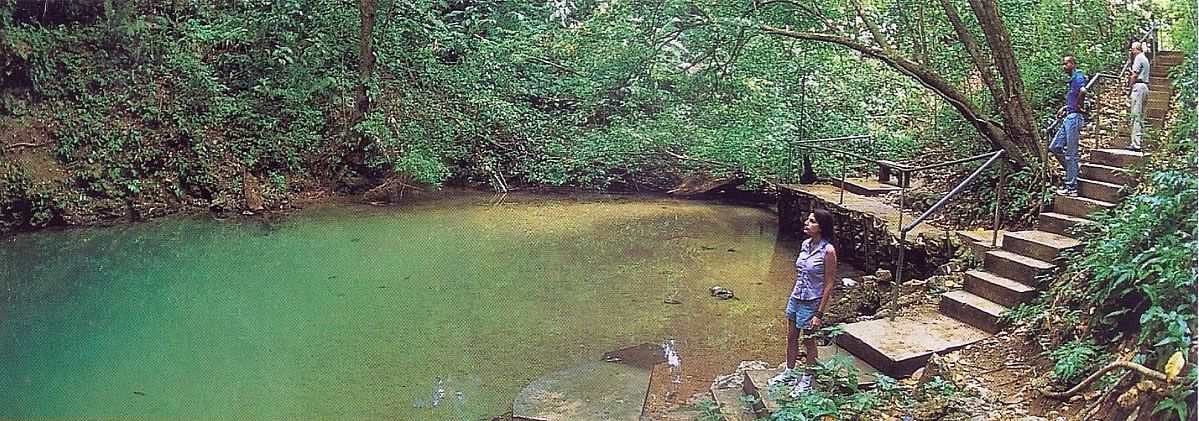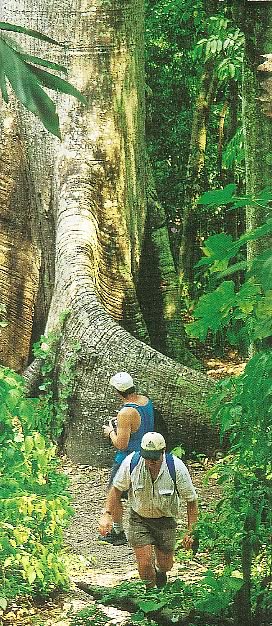Inland Blue Hole
The St. Herman’s Blue Hole National Park is among the many popular inland attractions in Belize. It is located just off the Hummingbird Highway in the Cayo District.
Perfect for a refreshing swim, this spot features an underground river that converges into a crystalline pool surrounded by lush greenery. It is a limestone cave formation filled with water that reflects an incredibly blue color – hence the name. This geological formation is part of the massive Belizean cave system that has been largely unexplored.
The park is over 500 acres (2 km) in size, and contains two cave systems (St. Herman’s and Crystal), various trails, and the cool jungle pool from which the park gets its name. This area is also home to a variety of wildlife, and trees are labeled for identification. Over 200 bird species were discovered here.
The Government of Belize acquired the land for the park in the 1960s and ’70s. It was officially declared a national park on November 23, 1986.
*Note: This inland “blue hole” is not to be confused with the offshore Great Blue Hole at Lighthouse Reef Atoll.
 Stairs from along the Western Hwy leading down to the Blue Hole
Stairs from along the Western Hwy leading down to the Blue Hole
Guanacaste National Park

The history of Guanacaste National Park is both fascinating and unique. Notably, the park derives its name from a massive Guanacaste tree that avoided being logged due to its trunk splitting into three bases, which diminished its value as timber. The park is also home to a variety of other tree species, including the rain tree, mamey sapote, Brazilian firetree, and Honduras mahogany, which is Belize’s national tree.
Managed by the Belize Audubon Society, the park is primarily operated as a bird sanctuary. In addition, the park showcases two distinct types of forest, which provide habitats for a diverse array of animals. It is home to over 100 bird species, making it a haven for bird enthusiasts and wildlife lovers alike.
Belize’s reputation for an extensive biodiversity is evident in the park. Animals, including the white-tailed deer, jaguarundi, kinkajou, nine-banded armadillo, and countless others, are observed by visitors. Bird species, including the Lesson’s motmot, black-faced antthrush, smoky-brown woodpecker, black-headed trogon, red-lored amazon, and magnolia warbler, are just a few of the species seen.
Activities
Although Guanacaste National Park is the smallest park in Belize, spanning just over 50 acres, it is undeniably one of the richest in natural beauty and biodiversity. For hikers, wildlife enthusiasts, and nature lovers, this park offers a remarkable experience. Furthermore, it’s over two miles of scenic hiking trails that provide an excellent introduction to the untamed beauty of Belize’s forests. In addition, several overlook decks are strategically placed throughout the park, allowing visitors to observe birds or simply marvel at the stunningly pristine environment. To top this off, a timber deck along the riverbank offers a perfect spot for cooling off with a refreshing swim.
Guanacaste National Park is remarkably easy to access, as it is conveniently located on the north side of the Western Highway, approximately 50 miles (80 km) west of Belize City, in the Cayo District. Furthermore, the park welcomes visitors every day of the year, with operating hours from 8:00 AM to 4:30 PM. To enhance your experience and ensure safety, it is advisable to wear long-sleeved shirts, sturdy shoes, and pants, especially to avoid contact with potentially poisonous plants.